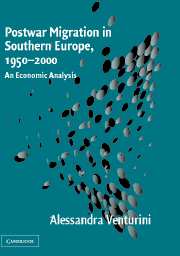Book contents
- Frontmatter
- Contents
- List of Figures and Tables
- Acknowledgments
- Introduction
- 1 The Evolution of Migration in Southern European Countries
- 2 The Choice to Migrate
- 3 The Effects of Immigration on the Receiving Country
- 4 The Effects of Emigration on the Country of Origin
- 5 The Effectiveness of Migration Policies
- References
- Index
3 - The Effects of Immigration on the Receiving Country
Published online by Cambridge University Press: 25 June 2009
- Frontmatter
- Contents
- List of Figures and Tables
- Acknowledgments
- Introduction
- 1 The Evolution of Migration in Southern European Countries
- 2 The Choice to Migrate
- 3 The Effects of Immigration on the Receiving Country
- 4 The Effects of Emigration on the Country of Origin
- 5 The Effectiveness of Migration Policies
- References
- Index
Summary
This chapter concentrates on the welcome and unwelcome effects of immigration on the labor market and economy of the receiving country. We do not rehash the well-worn discussion of immigrant integration and assimilation, mentioning it only marginally in the wider context of the economic effects immigrants can have. We start with a survey of the main theoretical and empirical results derived from studies conducted in the United States and Europe, presenting, where available, results for the southern European countries. Special attention is given to the question of complementarity or substitution between groups of workers. Empirical evidence from the United States, Canada, Australia, and northern Europe is used to interpret the southern European cases and is compared to the limited research available for these countries. The aim is to assess the impact of illegal as well as legal immigrants on native wage and employment growth.
AN OVERVIEW OF MODELS BY MAIN THEMES
Four main lines of approach can be identified. The first analyzes the role played by foreigners in the labor market (complementarity or substitution), and the second studies how foreigners integrate into the structure of wages and jobs. The third examines the contribution of immigrants to economic growth in the receiving country, and the fourth tries to assess the impact immigrants have on social expenditure.
These four approaches are exclusively economic, and they should be integrated with analyses of the demographic consequences of immigration. Demographic changes affect an economic system deeply.
- Type
- Chapter
- Information
- Postwar Migration in Southern Europe, 1950–2000An Economic Analysis, pp. 94 - 167Publisher: Cambridge University PressPrint publication year: 2004
- 2
- Cited by



